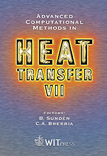Analysis Of Fluid Flow And Heat Transfer In District Heating Pipelines Using The Finite Element Method
Price
Free (open access)
Transaction
Volume
35
Pages
10
Published
2002
Size
2407 kb
Paper DOI
10.2495/HT020021
Copyright
WIT Press
Author(s)
I Gabrielaitiene, B Sundén & R Kacianauskas
Abstract
The finite element method is applied to solve coupled steady-state fluid flow and heat transfer problems in insulated pipes of district heating networks. The main advantage of the finite element method involved here is the standard discretization and solution technique for both coupling of temperature-dependent physical properties in the thermo-hydraulic flow and for description of the multilayered structure of insulation, which may also be situated in the environment, such as soil or air. In order to describe the above problem in a standard manner, the complex thermo-hydraulic macro element has been proposed. This element presents a combination of a standard hydraulic pipe element and one-dimensional thermal elements of the ANSYS code. The proposed approach is used to investigate temperature-dependent fluid properties and the role of the coupling in district heating pipe lines.
Keywords





